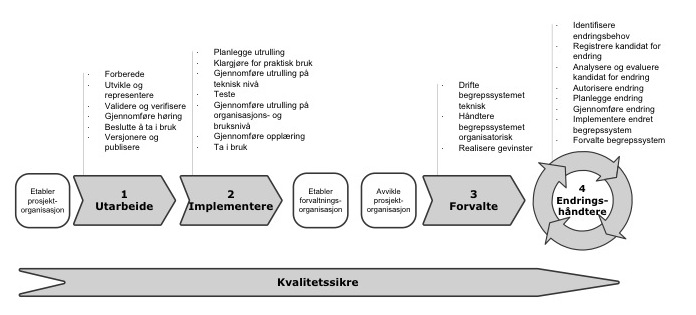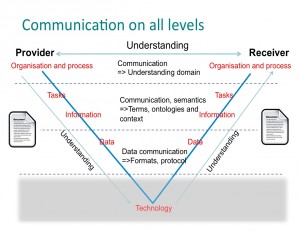There exists many documents and guidelines on terminology and concepts, both generally and specially. Semicolon have collated this documentation and tacit experiences from different departments into a holistic lifecycle process for concepts and terminology work.
The illustration below describes Semicolons suggestion for a lifecycle process for concepts and terms with associated main processes. The process is iterative, since the terms will be in constant flux illustrated in main process #4 (Change management). Public government are mainly the organisation maintaining concept systems on a daily basis, howevere the concept systems are ususally developed in projects. When major revision of the concept systemss are necessary these could be managed in separate projects.

Figure – Concept system lifecycle
This is a short description of the different processess, a more complete description is in the report (only in Norwegian):
- Develop: Develop a representation of the concept systems. Validate and verify its relevance. Ask for stakeholder contributions. A government agency desides implementation of the concept system. The concept system is versioned and published.
- Implement: Plan for deployment and practical use. Deploy the concept system on technical-, organisationa- and usage-level, including training.
- Governance: Run the concept system on a technical level, maintain it on the organsiational level, realise the benefits.
- Change management: Identify changes, recommend changes, analyse and plan for the change. Consider the need to establish a separate project to make the change, or if the governing agency could manage. Implement the changes, govern the new concept systems.
- Quality assurance: The concept system must be quality assured during the whole lifecycle.
This process is extensively described by Vibeke Dalberg, Per Myrseth and Jim Yang in the document (in Norwegian): Lifecycle process for development and governance of concept systems, february 2011. Visio concept model.
This lifecycle process are used and evaluated by many of the practical cases in the Semicolon project that are related to concept definitions.
- Paramedic chain
- Corporate register
- Accounting register

